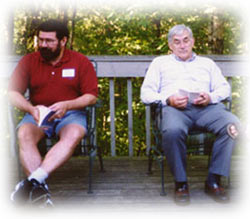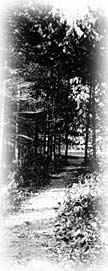Haiku
Society of America Midwest Haiku Retreat
Minneapolis, Minnesota
|
Midwest
Haiku Retreat
|
Second 1999 HSA Quarterly Meeting June 11-13, 1999, Minneapolis, MNThe Second 1999 HSA Quarterly Meeting was held June 11-13, 1999 at Wilder Forest, a wooded retreat center near Minneapolis, Minn. Midwest Regional Coordinator Randy Brooks teamed up with Jeanne Emrich to organize the Midwest Haiku Writers Retreat with an emphasis on doing haiku-related activities. The retreat featured: haiku readings, collaborative linked haiku writing, editing haiku, painting haiga, ginkô haiku walks, judging haiku, and a closing discussion about approaches to haiku journals. |
||||||
|
As we discovered at the opening introductions, the retreat attracted a variety of participants from across the United States, including HSA members from Connecticut, Massachusetts, Pennsylvania, California, Nebraska, Illinois, Michigan, Iowa, and, of course, Minnesota. Several participants came with partners, often based on previous collaborations between artists and haiku poets, perhaps attracted to our advertised workshop on haiga painting. The participants ranged in experience from scholars and longtime haiku writers to beginners, which made for excellent exchanges throughout the weekend. |
|||||||
|
Paul
O. Williams, President of HSA, (in the photo above with Dr. Brooks)
was the featured speaker on Friday evening. He shared an investigation
of human knowledge about the moon, and how haiku writers have captured
the lunar significance to our lives. His talk included more than
a hundred excellent lunar haiku, including several by Robert Mainone,
one of the retreat participants:
One of the joys of haiku is the exactness of observation captured by haiku poets. Paul blended the scientific with the literary knowledge of the moon to show that we are always seeking to understand those things we live with. Following the moon presentation, all participants shared haiku in extended rounds of haiku reading. A few participants stayed up late Friday night learning how to write rengay, following the guidance of Paul Williams and Randy Brooks. Here is a rengay written by Paul O. Williams, Hal Barron and Horst Ludwig:
After breakfast Saturday morning, we gathered on the deck of the lodge for a haiku editing workshop. Prior to the retreat, participants sent haiku to Lee Gurga to be edited in this workshop, so he had time to prepare a variety of editing experiences for us. He began by picking on his good friend and long time haiku-editing buddy, Randy Brooks, who contributed this haiku for editing suggestions:
Deliberately misreading this haiku attempt Lee asked me, "Randy, why is your mother carrying your arm from grave to grave?" And all of the participants began working on ways to fix this haiku:
I promised to share a final version with them the next morning and came up with this rendering after a joke about my mother "pulling my leg" from grave to grave:
Another example from the editing workshop is the following revision by Ann Brown, one of the newcomers to haiku at the retreat:
|
After the extensive presentation, we moved to the Wilder Forest studios to try our hands at haiga painting. Jeanne provided quality brushes, examples, books, paints and a chop (and red cinnabar) we could share for our works. Several of the resulting haiga can be viewed on the Web. Here
is a haiga by Randy Brooks created at the painting workshop: The studio remained open until Saturday evening for those who wanted to continue working on haiga. Most of the haiga were posted on the lodge walls so that they could be enjoyed until the end of the retreat. On Sunday morning, we voted on favorites, and Jeanne led a critical discussion appreciating various works. Jeanne's haiga of snow on the stair steps and Hayat Abuza's delicate feathers haiga were the favorites. We were also treated to a slide show of photography and haiku Saturday evening by calendar collaborators, Gretchen Batz and Nancy Wiley, from Elsah, Ill. On Saturday afternoon, Horst Ludwig, Associate Professor of German at Gustavus Adolphus College, gave a comprehensive one-hour presentation on the history of haiku by German poets. Horst's presentation was thoroughly researched and appropriately critical of the writers, editors, magazines, and anthologies of German haiku from the turn of the century to contemporary times. The main literary obstacle to writing haiku in a language other than Japanese appears to be that the poets are, of course, always attempting to continue their own Western concepts of poetic work (and these concepts are often at odds with the Eastern aesthetics and approaches espoused by the Japanese haiku tradition). Horst showed how the German poets have wrestled with Romanticism and the ego-less poetics championed by the haiku tradition. In the late afternoon, the retreat folks participated in a ginkô, hiking trails leading through the 1,200 acres of woods and around the glacial lakes. Several participants saw a turtle laying eggs on an esker between the lakes and shared these moments during a retreat reading roundtable. Here are some of the first draft haiku resulting from the ginkô. The first is by Lee Gurga and the second by Charlie Trumbull:
Randy Brooks led the group through a method of judging haiku by discussing matched pairs of haiku. This method of haiku criticism dates back to haiku competitions judged by Bashô. Although we called this method "matching walnut shells" as a Midwestern term, it is more typically associated with "matching seashells," a game played by Japanese girls. On Sunday morning, Randy led the group through a discussion of the haiku from the ginkô, arranged in matched pairs by Lee Gurga. The favorite haiku from the ginkô competition was another turtle haiku by Hayat Abuza:
Charlie's "cottonwood fluff" haiku received second place. Both winners of the ginkô competition received a book of their choice from Brooks Books. On Sunday morning, after selecting the awards for the ginkô and haiga, we had another delightful round of haiku reading on the deck of the lodge. Then perhaps the best event of the entire retreat occurred. We had about an hour before we needed to pack up, so everyone simply went into an open-ended discussion about writing haiku, keeping haiku journals, why do some people write haiku as sentences, and so forth. It was a great conclusion to the retreat! —Randy Brooks, Midwest Region Coordinator |
||||||
| © 2001, Dr. Randy Brooks• Millikin University |
last
updated 8/21/01 • about this web site
|

 After
the haiku editing workshop, Jeanne Emrich presented a history
of haiga, complete with slide exhibits. Basic principles of expressive
creation and complementary connections between the poetry and
painting were emphasized (in contrast to Western concepts of illustration
and description). Jeanne also showed us the wide range of approaches
taken by various writers and painters, both from Japanese history
and in contemporary works by living artists.
After
the haiku editing workshop, Jeanne Emrich presented a history
of haiga, complete with slide exhibits. Basic principles of expressive
creation and complementary connections between the poetry and
painting were emphasized (in contrast to Western concepts of illustration
and description). Jeanne also showed us the wide range of approaches
taken by various writers and painters, both from Japanese history
and in contemporary works by living artists.